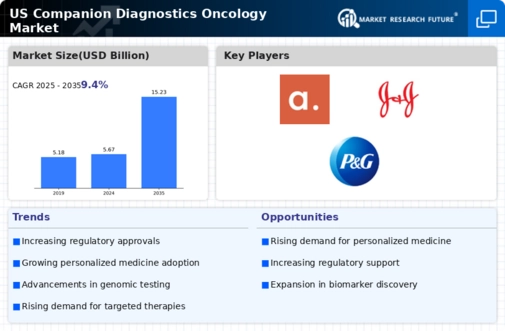Rising Incidence of Cancer
The increasing incidence of cancer in the United States is a primary driver for the companion diagnostics-oncology market. According to the American Cancer Society, approximately 1.9 million new cancer cases are expected to be diagnosed in 2025. This surge in cancer cases necessitates the development of targeted therapies, which rely heavily on companion diagnostics to identify suitable patients for specific treatments. The companion diagnostics-oncology market is thus positioned to grow as healthcare providers seek to enhance treatment efficacy and patient outcomes. Furthermore, the demand for personalized medicine is likely to escalate, as patients increasingly expect tailored treatment plans based on their unique genetic profiles. This trend indicates a robust market potential for companion diagnostics, as they play a crucial role in the precision medicine landscape.
Advancements in Genomic Technologies
Technological advancements in genomic sequencing and analysis are significantly impacting the companion diagnostics-oncology market. Innovations such as next-generation sequencing (NGS) have made it possible to analyze multiple genes simultaneously, thereby facilitating the identification of biomarkers associated with various cancers. The market for genomic testing is projected to reach $10 billion by 2026, reflecting a growing reliance on these technologies in oncology. As healthcare providers adopt these advanced diagnostic tools, the companion diagnostics-oncology market is expected to expand, driven by the need for accurate and timely identification of suitable therapies. Moreover, the integration of genomic data into clinical practice enhances the ability to match patients with the most effective treatments, further solidifying the role of companion diagnostics in modern oncology.
Increased Investment in Cancer Research
The companion diagnostics-oncology market is benefiting from increased investment in cancer research and development. In 2025, funding for cancer research in the United States is projected to exceed $50 billion, driven by both public and private sectors. This influx of capital is likely to accelerate the discovery of new biomarkers and the development of innovative companion diagnostics. As pharmaceutical companies invest in targeted therapies, the need for companion diagnostics to identify patient populations becomes paramount. This trend suggests a symbiotic relationship between drug development and companion diagnostics, where advancements in one area fuel growth in the other. Consequently, the companion diagnostics-oncology market is poised for substantial growth as research initiatives continue to expand.
Growing Demand for Personalized Medicine
The shift towards personalized medicine is a significant driver of the companion diagnostics-oncology market. Patients and healthcare providers are increasingly recognizing the value of tailored treatment approaches that consider individual genetic profiles. This trend is reflected in the rising adoption of companion diagnostics, which enable clinicians to select the most appropriate therapies based on specific biomarkers. The market for personalized medicine is expected to reach $2 trillion by 2025, indicating a robust demand for companion diagnostics that support these initiatives. As healthcare systems prioritize patient-centered care, the companion diagnostics-oncology market is likely to experience sustained growth, driven by the need for precision in treatment selection and improved patient outcomes.
Regulatory Support for Companion Diagnostics
Regulatory bodies in the United States are providing increasing support for the development and approval of companion diagnostics, which is a key driver for the market. The FDA has established clear pathways for the approval of these diagnostics, facilitating their integration into clinical practice. In 2025, the number of approved companion diagnostics is expected to rise significantly, reflecting the regulatory environment's responsiveness to the need for personalized treatment options. This supportive framework encourages innovation and investment in the companion diagnostics-oncology market, as companies seek to develop new tests that align with regulatory standards. As a result, the market is likely to expand, driven by the increasing availability of approved companion diagnostics that enhance treatment decision-making.














Leave a Comment